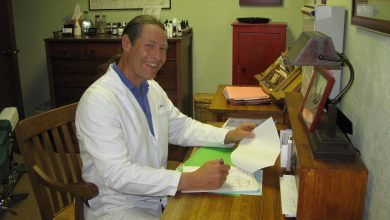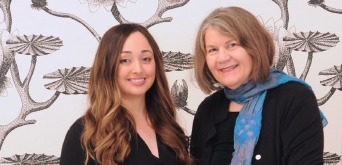Mary Ehlers – Big Benefits from Myofascial Release Massage
Myofascial release has gained a strong following because research is showing it works, therapists can feel that it works, and clients are saying it works. The body does not work as separate parts, and myofascial release recognizes that our fascia is one of the main things that connect all the parts into a whole. This therapy relaxes tight muscles effectively and allows the whole body to learn what balance feels like.
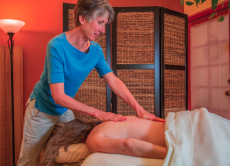 Mary, congratulations on your success as a massage therapist here in Ashland. I understand that is partly due to your use of myofascial release techniques. Can you tell us what “myofascial” means?
Mary, congratulations on your success as a massage therapist here in Ashland. I understand that is partly due to your use of myofascial release techniques. Can you tell us what “myofascial” means?
Thanks, Shields. I really appreciate the Locals Guide, because it’s such a great way to tell folks about myofascial release and how effective it is in becoming more relaxed and pain-free.
“Myo” refers to our muscles, and “fascia” refers to the connective tissue that surrounds the muscles. Fascia is very elastic and very strong. Individual fascia fibers are extremely movable and work in concert with each other. If you enjoy seeing how things work inside the body and would like to see living fascia at work, I strongly recommend you watch this youTube video. You’ll see that fascia is beautiful, pearly white, and filled with moisture, one fiber moves this way, while another moves a different way to compensate.
Fascia surrounds and interweaves with everything. It covers whole muscle groups, like the bicep muscle, and it also surrounds every muscle fiber bundle and every individual muscle fiber. Fascia allows smooth movement not only of muscles but also tendons and ligaments, which slide within a tunnel of fascia.
Besides muscles, fascia surrounds and interweaves through bones and organs. We often hear the phrase, “Everything’s connected,” well, this is how everything is connected. If all the bones, organs, and muscles were removed, there would be the fascia, completely in the shape of your body. This is why a restriction in the fascia in one part of the body might set up a tension in the fascia system that goes to a completely different part of the body.
Both the muscle and the fascia are filled with nerves, blood vessels, and sensory cells that feel pain and pressure, and create either tension or relaxation responses in the body. There are actually more sensory cells in the fascia than in the muscle.
So the word “myofascial” recognizes that we’re working with a system of muscle and fascia, both of which can cause tension or relaxation.
What could cause problems with the myofascial system?
Well, life happens. Muscles and fascia can react to various life situations by tightening and toughening, as a protective measure. This restricts blood flow, so if the stimulus to tighten is not removed, the area can become even tighter, until eventually it causes real discomfort and/or lack of mobility. Some typical reasons for muscles and fascia to become chronically tight are poor posture, repetitive overuse, stress, trauma (such as a car accident), skeletal abnormalities, and lack of movement, among others.
In this day and age, we are particularly at risk because we sit a great deal, rarely use large muscle movements (swinging arms, rotating body, striding), and do many things in a head down and forward position (cell phones, computers, reading books). We live with our bodies often flexed forward, which means our muscles tighten up to accommodate our head forward and our shoulders and back rounded. Your head should sit on top of your vertebrae. Every inch forward it is from this ideal position feels like your head weighs an extra 10 pounds. So if your head is two inches forward, it’s like having an extra 20 pounds for your neck and upper back muscles to hold up!
 How does myofascial massage help with this? What would a massage feel like?
How does myofascial massage help with this? What would a massage feel like?
With myofascial release, I use long, very slow strokes, which compress and stretch the fascia and muscle. This can be on broad muscle groups like the trapezius and the muscles that underlie the trapezius in the upper back and top of the shoulders. Or it can be on very specific smaller muscles, like one of the scalene muscles in the neck that help to bring the head back out of the head-forward posture.
The sensory cells in the fascia and muscles feel the stretch and pressure, and react by relaxing. It takes energy for the body to keep muscles and fascia in a tightened state, and when that energy is released by relaxing the muscle, it can be felt throughout the whole body.
This works whether the pressure I use is light or deep or somewhere in between, so I can work to the preference of the client and still feel the tissues become more elastic and mobile.
I use myofascial techniques in combination with other massage techniques. Good ol’ Swedish massage is just so relaxing, deep tissue is wonderful and effective for those who like it, trigger point work can get at those chronically tight places a little more aggressively, and my awareness of where different kinds of sensory cells reside allows me to encourage the relaxation response we’re looking for.
The client usually feels a strong sense of relaxation and letting go, that “ahhh” feeling. Sometimes, as I’m feeling a muscle or muscle group relaxing, the client also feels the tight area let go. When the massage is over, the client’s movement is freer and smoother. What has happened is that the whole body has become more balanced now that certain muscles aren’t “holding on tight.”
What do you recommend to a client to maintain that balanced feeling and improved mobility?
Recently I’ve become more and more aware of how important it is to combine massage with exercise. Whatever the problem that caused your muscle tension in the first place, it probably won’t go away permanently with just massage. Since everything you feel is really in your brain, massage reminds your brain what relaxation feels like. After a massage, you will feel relaxed and light, so this is the time to pay attention to how your body feels in this relaxed state, appreciate it, enjoy it.
In a day or two, you may feel tight again, since muscles and fascia tend to revert to their previous state. As you exercise you will change patterns in your body that have created your chronic tightness. Massage moves the muscles into proper alignment at least temporarily and reminds your brain what your body feels like when it’s relaxed. Your exercise program helps your body to actually achieve a new balance, allowing the muscles and fascia to relax on a more permanent basis.
 What types of conditions or clients are best suited for working with you?
What types of conditions or clients are best suited for working with you?
Upper back/neck/shoulder! That is definitely a major complaint. I used to think tension in these muscles was caused by stress, but more and more I’m seeing that chronic postural problems are also a main indicator.
The next most common complaint is lower back and hip aches, often caused by too much sitting, long car rides, improper lifting, that sort of thing. The main reason for these problems is usually that the person needs more strength and flexibility in the core.
Although I work on younger people, I think I attract people who are middle age and up because I’m in that age group myself. Among that group of people, there are folks who are very physical and active and some who are more sedentary. There are those who love deep tissue work and others who want very light work.
Everyone is so different, and each time they come they may present with slightly different issues. Therefore, I come to each massage like it’s an open book, allowing me to feel the areas of tightness, to get feedback from the client, and to devise a plan of action as I go. I love this work because it’s very creative finding what a person needs and the best way to solve any problems. Of course, the other reason I love my work is because I enjoy my clients so much!
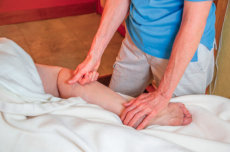 Mary, tell us a little about yourself and how you got into this work.
Mary, tell us a little about yourself and how you got into this work.
It seems like I’ve been doing massage all my life, since my parents and my sister and I gave massages to each other while I was growing up. They were hand massages and head and back. None of us had ever had a professional massage.
In my 30s, I was looking to find an area to work in that I would really love, and I thought back to our family massages. I found a great teacher in Seattle, a Swedish woman who taught Swedish massage. I practiced on my kids who were always ready to help Mom out by being willing guinea pigs.
I wasn’t able to turn this into a profession at that time, and then I got waylaid by farming culinary herbs when I moved to the Rogue Valley in 1993. Much as I loved that, I finally decided to return to massage, completing Oregon education requirements at RCC and getting licensed. I worked in Medford for five years and have now been working in Ashland for about four years.
I always say that massage therapy has got to be one of the best fields to work in because people are happy when they come in, knowing you will make them feel better, and they are happy when they leave because they do feel better.
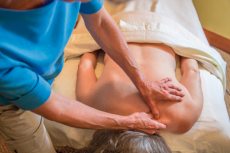 What kind of feedback do you get from your clients?
What kind of feedback do you get from your clients?
Sometimes the feedback is when clients show me how they can newly swing their arm in big circles. Or how they can bend over without pain. Or when I see them walk out, they’re standing straighter and walking more lightly.
Then there is the verbal feedback, when a client says, “I feel great,” or “I could feel those muscles just letting go,” or “When can I come back and do this again?”
Recently I’ve been asking my clients what they feel for them is the benefit of massage. Here are some of their answers:
“As I age, it helps my muscles stay loose and more mobile.”
“It’s relaxing, soothing, and comforting.”
“Mary, you take me to another world!”
“It keeps the blood flowing and the lymph moving.”
“Mary, you are part of my health program.”
How can folks get in touch with you?
I look forward to talking to anyone by phone to decide if massage would be beneficial and to make appointments. My number is 541-499-1199.
Learn More:
Mary Ehlers, LMT
541-499-1199


